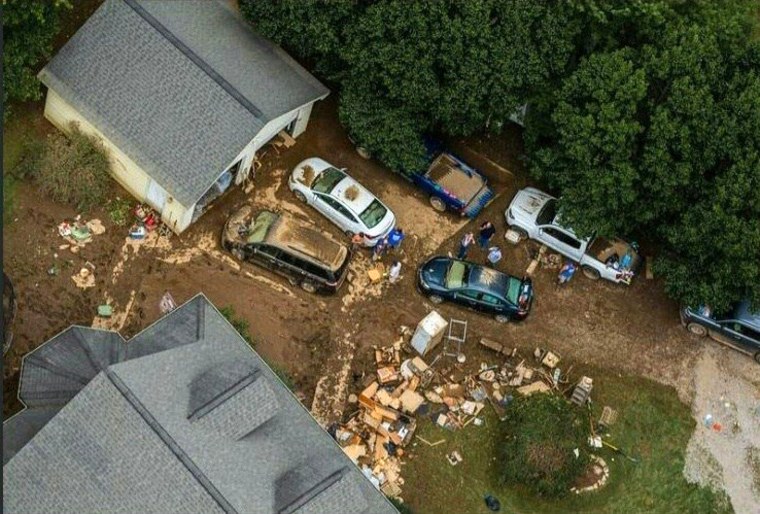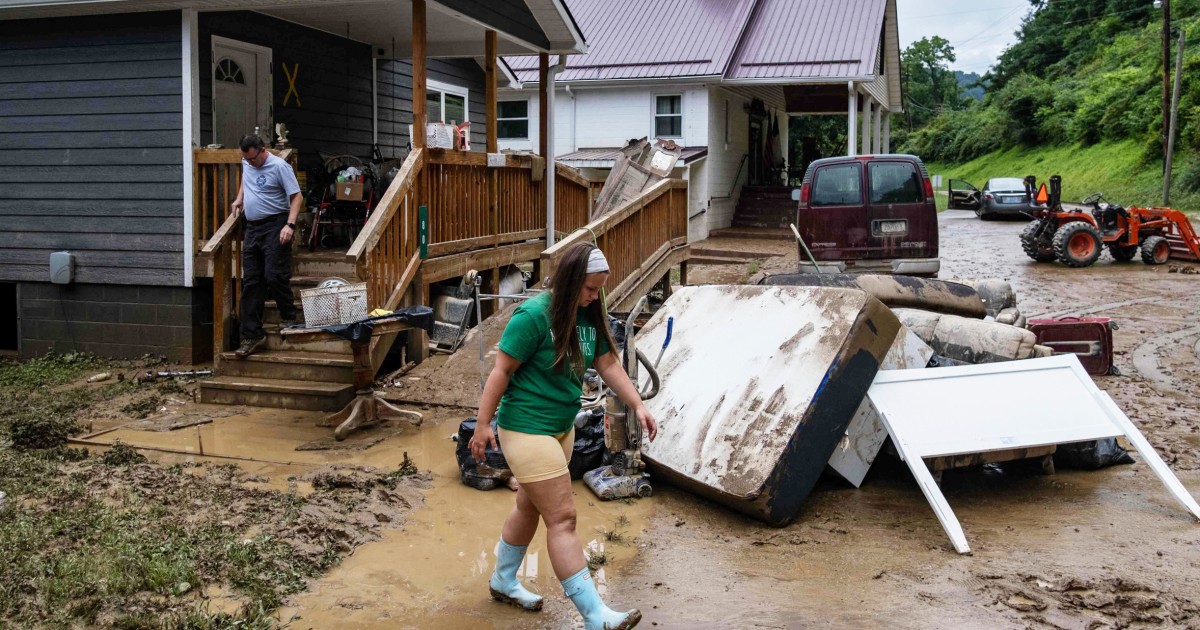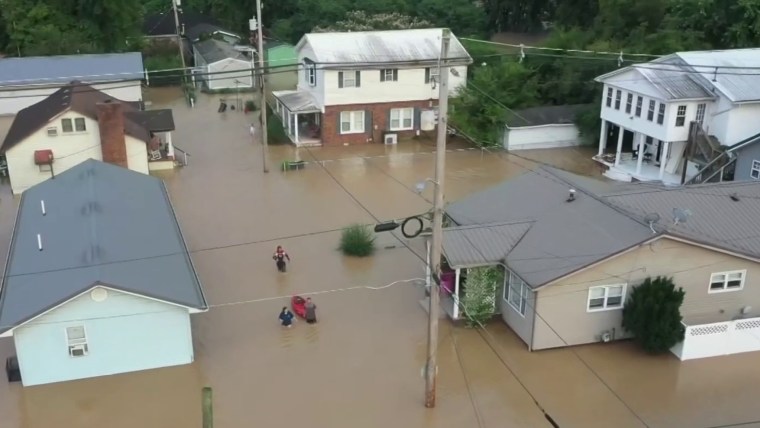As eastern Kentuckians continue to search for missing loved ones, muck out their homes and prepare for more rain, they are beginning to ask who could be at fault for this past week’s deadly flooding and whether it was a natural disaster or one caused by the coal mines that have drastically reshaped and scarred the landscape.
Compacted dirt, destroyed mountaintops and deforestation in eastern Kentucky have often been left ignored by the coal companies that mined there, despite legal requirements that they attempt to return the land to its natural state when mining concludes. In recent decades, that spurned responsibility has, at times, turned heavy rains into floods and caused local residents who once counted on mining for jobs and prosperity to bring litigation against their former employers in Appalachian courtrooms.
Lawyers who have pursued these cases in the past said it is still too early to pursue a case in the most recent flooding, as studies need to be conducted and claimants contacted, but interest in holding someone to account for the lost homes and at least 37 dead is growing.
“It may be too early to tell, but I’ve received a couple phone calls already,” said Ned Pillersdorf, a Kentucky lawyer in Prestonburg who has successfully sued coal companies for flood damage in the past. “No one is denying the amount of rain we had — it truly was a 1,000 year event — but did the strip mines contribute? Absolutely.”
Kentucky, particularly the eastern mountains, are littered with abandoned coal mines. Many are a result of strip mining or mountaintop removal mining, the latter a method in which mining companies use explosives to blast off a mountain’s summit to get to the coal inside.
Pillersdorf, whose home was flooded, noted that the areas worst hit in his county are the ones closest to the strip mines.
“It is obviously just a clear slam dunk in terms of corporate irresponsibility,” said Alex Gibson, the executive director of Appalshop, the culture and education center in Whitesburg that was hit by more than 6 feet of water. “And of how we can predict an outcome and ignore all the signs along the way until the tragedy happens and then act like, ‘Yeah, but we didn’t see it coming. It was God’s work.'”
The Kentucky Coal Association, which represents the state’s mining operations, did not immediately respond to a request for comment.
The loss of the natural ridge lines, vegetation and trees, and the cracks in the mountains that are largely owned by companies often funnels rainwater into the thin valleys, or low-lying hollows, where most eastern Kentuckians make their homes.
Without these natural protections, regional flooding has grown as climate change brings new levels of precipitation up from the Gulf Coast to Appalachia.
“They’re saying it’s a natural disaster, but I’m sorry. This is a disaster that was made by a whole bunch of mining that’s been going on for the past 40 years,” said Jack Spadero, the former director of the National Mine Health and Safety Academy who has testified as an expert witness in numerous coal mine lawsuits in recent years.“It has changed the landscape of eastern Kentucky dramatically.”
‘Like pulling teeth’
The Surface Mining Control and Reclamation Act of 1977, or SMCRA, was a federal regulation that was supposed to prevent coal companies from leaving abandoned mines behind. The law required mine owners to reclaim the land and return it to its natural form as much as possible. In the ensuing 45 years, many companies have avoided that work and many states in the region, like Kentucky, turned a blind eye to it.
Now, there are more than 2,800 entries for Kentucky in the national inventory of known-abandoned mine land, according to a Department of Interior database, and much of it is located in the state’s eastern hill country. Experts also said that the number in the inventory is likely a conservative figure and that recent coal company banks have made it more difficult to pursue accountability.
SMCRA required every state to enforce the financial responsibility and claim obligation of the coal mine operators in their state. While some states required mining companies to pay claim costs upfront, others — like Kentucky — allowed them to put up a bond for the potential costs. In the past, small companies in Kentucky were allowed to create a pooled fund, while larger ones were able to self-bond, but the majority were done through a third party.
“There are surety companies that are holding these bonds, which are woefully inadequate to do the real claim work, but many are even fighting to turn over those bonds, so it’s like pulling teeth,” said Joe Childers, who has litigated cases for vulnerable Kentuckians against major energy companies for more than 40 years. “In the meantime, nothing gets done. The hillsides are scarred, they’re not reclaimed and you get a rain event like last week and you have terrible flooding. And it was totally exacerbated by the lack of proper regulation.”

Since 2013, Kentucky requires companies to pay into a single bond pool through what essentially serves as a tax on a certain amount of acreage or coal tonnage. But the difference between the liabilities that were left behind and the trust fund the state created in 2013 has grown significantly.
John Mura, a spokesperson for The Kentucky Energy and Environment Cabinet, said by email that the state agency was “engaged right now organizing cabinet aid” to the affected areas and declined to comment further.
About 408,000 Kentuckians live within one mile of abandoned mine land, the regional think tank Ohio River Valley institute estimated last year, and it will cost nearly $1.2 billion to remediate it. As of 2020, the Kentucky fund had about $52 million in it, according to a state report.
Kentucky spent a little more than $1.5 million from its claim fund, according to the 2022 executive budget. The state is expected to receive an additional $75 million this year as part of President Joe Biden’s infrastructure law, which dedicated $11.3 billion toward abandoned mine claim over the next 15 years. Last year, the state received $9 million from the federal government.
The new sum is huge, but “it’s just a drop in the bucket” to address the need for communities across Appalachia, said Sarah Surber, a public health professor at Wayne State University who has studied environmental justice issues in the region and practiced law there for more than a decade.
“How do you prioritize [the funding]?” she said. “You have so many that have been left abandoned or sitting in limbo, you have more coal mine company bankruptcies anticipated, so how do you decide what mines get reclaimed and what does that mean for communities and their protection in terms of pollution and flooding issues?
Lawsuit challenges
Kevin Thompson, an attorney whose work earned national attention for challenging powerful coal CEO Don Blankenship, said the images he saw out of Kentucky this past week gave him flashbacks to the 2009 King Coal case he worked on in West Virginia and the photographs he took of the days after the flooding that happened there.
That case brought 20 low-income families against four powerful companies that Thompson argued were responsible for two flooding incidents that washed away people’s homes.

